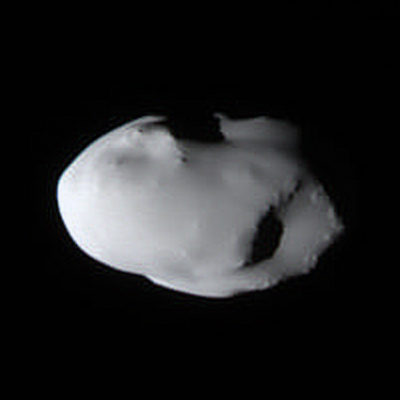Emily Lakdawalla • May 18, 2010
Dione and Telesto, close on camera but far apart in fact
This image, released today by Cassini's imaging team, is pretty cool; it shows one of Saturn's larger moons together with one of its smaller ones. I probably noticed the nice photo of Dione when it appeared on the Cassini raw images page two months ago, but I know I didn't notice the little speck below and to the left of the bigger moon. That speck is a small moon, Telesto.

As it turns out, the contrast in size between the two moons is not as great as this photo makes it appear. For two moons to appear in one Cassini photo, they both have to lie along the same line of sight. But that doesn't mean they need to be physically close in space. Dione orbits Saturn at a distance of not quite 400,000 kilometers from the center of the planet. Telesto is on a different orbit; it shares the orbit of Tethys which is just shy of 300,000 kilometers from Saturn's center. So the two moons can never approach each other to a distance closer than 100,000 kilometers.
But they're actually much farther apart than that. I used the PDS Rings Node Saturn viewer tool to figure out that for Cassini to see Dione and Telesto in the same frame, the photo had to be taken at about 5:40 on March 4, 2010. Then I plugged that time into JPL's Solar System Simulator to see the relative positions of Cassini and Saturn's moons at the time. Cassini was about half a million kilometers away from Dione, and both were on the same side of Saturn. Tethys, on the other hand, was on the far side of Saturn, and Telesto, which travels 60 degrees of longitude ahead of Tethys in its orbit, was also on the far side of Saturn. So Telesto was more than a million kilometers from Cassini when this photo was snapped. As a result, Telesto looks less than half the size it would appear if it were actually lying at the same distance from Cassini that Dione is in this picture.
Here's what Telesto looks like up close.

Support our core enterprises
Your support powers our mission to explore worlds, find life, and defend Earth. You make all the difference when you make a gift. Give today!
Donate

 Explore Worlds
Explore Worlds Find Life
Find Life Defend Earth
Defend Earth

